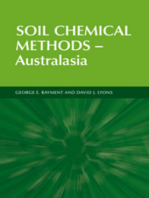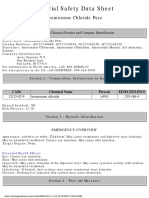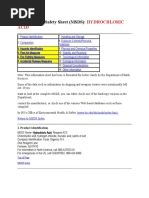0 ratings0% found this document useful (0 votes)
138 viewsMSDS Benzyl Alcohol
MSDS Benzyl Alcohol
Uploaded by
Tiara RiaBenzyl alcohol is a colorless to pale yellow liquid with an aromatic odor and faint odor. It is harmful if inhaled or swallowed and can cause moderate eye and skin irritation. Proper personal protective equipment should be worn when handling including chemical splash goggles, gloves, protective clothing, and respirators if exposure limits are exceeded. Benzyl alcohol is flammable and should be stored away from sources of ignition in a cool, dry, tightly closed container under nitrogen.
Copyright:
© All Rights Reserved
MSDS Benzyl Alcohol
MSDS Benzyl Alcohol
Uploaded by
Tiara Ria0 ratings0% found this document useful (0 votes)
138 views6 pagesBenzyl alcohol is a colorless to pale yellow liquid with an aromatic odor and faint odor. It is harmful if inhaled or swallowed and can cause moderate eye and skin irritation. Proper personal protective equipment should be worn when handling including chemical splash goggles, gloves, protective clothing, and respirators if exposure limits are exceeded. Benzyl alcohol is flammable and should be stored away from sources of ignition in a cool, dry, tightly closed container under nitrogen.
Original Description:
msds
Copyright
© © All Rights Reserved
Share this document
Did you find this document useful?
Is this content inappropriate?
Benzyl alcohol is a colorless to pale yellow liquid with an aromatic odor and faint odor. It is harmful if inhaled or swallowed and can cause moderate eye and skin irritation. Proper personal protective equipment should be worn when handling including chemical splash goggles, gloves, protective clothing, and respirators if exposure limits are exceeded. Benzyl alcohol is flammable and should be stored away from sources of ignition in a cool, dry, tightly closed container under nitrogen.
Copyright:
© All Rights Reserved
0 ratings0% found this document useful (0 votes)
138 views6 pagesMSDS Benzyl Alcohol
MSDS Benzyl Alcohol
Uploaded by
Tiara RiaBenzyl alcohol is a colorless to pale yellow liquid with an aromatic odor and faint odor. It is harmful if inhaled or swallowed and can cause moderate eye and skin irritation. Proper personal protective equipment should be worn when handling including chemical splash goggles, gloves, protective clothing, and respirators if exposure limits are exceeded. Benzyl alcohol is flammable and should be stored away from sources of ignition in a cool, dry, tightly closed container under nitrogen.
Copyright:
© All Rights Reserved
You are on page 1of 6
Material Safety Data Sheet
Benzyl alcohol
Section 1 - Chemical Product and Company Identification
MSDS Name: Benzyl alcohol
Catalog 10584-0000, 10584-5000, 14839-0000, 14839-0010, 14839-0025, 14839-
Numbers: 0050, 37809-0000
Synonyms: Phenylmethanol
Acros Organics BVBA
Company Identification: Janssen Pharmaceuticalaan 3a
2440 Geel, Belgium
Acros Organics
Company Identification: (USA) One Reagent Lane
Fair Lawn, NJ 07410
For information in the US, call: 800-ACROS-01
For information in Europe, call: +32 14 57 52 11
Emergency Number, Europe: +32 14 57 52 99
Emergency Number US: 201-796-7100
CHEMTREC Phone Number, US: 800-424-9300
CHEMTREC Phone Number, Europe: 703-527-3887
Section 2 - Composition, Information on Ingredients
CAS# Chemical Name: % EINECS#
100-51-6 Benzyl alcohol >98.5% 202-859-9
Hazard Symbols: XN
Risk Phrases: 20/22
Section 3 - Hazards Identification
EMERGENCY OVERVIEW
Harmful by inhalation and if swallowed.Hygroscopic (absorbs moisture from the air).Air
sensitive.
Potential Health Effects
Eye: May cause moderate eye irritation. Causes redness and pain.
Causes moderate skin irritation. Prolonged and/or repeated contact may cause
Skin: defatting of the skin and dermatitis. Causes redness and pain. May be harmful if
absorbed through the skin.
Harmful if swallowed. May cause severe gastrointestinal tract irritation with
Ingestion:
nausea, vomiting and possible burns.
Harmful if inhaled. Inhalation of high concentrations may cause central nervous
Inhalation: system effects characterized by nausea, headache, dizziness, unconsciousness and
coma. May cause respiratory tract irritation.
Chronic: Prolonged or repeated skin contact may cause dermatitis.
Section 4 - First Aid Measures
Flush eyes with plenty of water for at least 15 minutes, occasionally lifting
Eyes:
the upper and lower eyelids. Get medical aid.
Get medical aid. Flush skin with plenty of water for at least 15 minutes while
Skin:
removing contaminated clothing and shoes.
Ingestion: Get medical aid. Wash mouth out with water.
Remove from exposure and move to fresh air immediately. If not breathing,
Inhalation: give artificial respiration. If breathing is difficult, give oxygen. Get medical
aid.
Notes to
Physician:
Section 5 - Fire Fighting Measures
As in any fire, wear a self-contained breathing apparatus in pressure-
General
demand, MSHA/NIOSH (approved or equivalent), and full protective gear.
Information:
Will burn if involved in a fire.
Extinguishing
Use water spray, dry chemical, carbon dioxide, or chemical foam.
Media:
Section 6 - Accidental Release Measures
General
Use proper personal protective equipment as indicated in Section 8.
Information:
Absorb spill with inert material (e.g. vermiculite, sand or earth), then
Spills/Leaks:
place in suitable container.
Section 7 - Handling and Storage
Avoid breathing dust, vapor, mist, or gas. Avoid contact with skin and eyes. Use
Handling:
only in a chemical fume hood.
Keep away from sources of ignition. Store in a cool, dry place. Store in a tightly
Storage:
closed container. Store protected from light. Store under nitrogen.
Section 8 - Exposure Controls, Personal Protection
Engineering Controls:
Facilities storing or utilizing this material should be equipped with an
eyewash facility and a safety shower. Use adequate general or local exhaust
ventilation to keep airborne concentrations below the permissible exposure
limits.
Exposure Limits
CAS# 100-51-6:
Personal Protective Equipment
Eyes: Wear chemical splash goggles.
Skin: Wear appropriate gloves to prevent skin exposure.
Clothing: Wear appropriate protective clothing to minimize contact with skin.
Follow the OSHA respirator regulations found in 29 CFR 1910.134 or European
Standard EN 149. Use a NIOSH/MSHA or European Standard EN 149
Respirators: approved respirator if exposure limits are exceeded or if irritation or other
symptoms are experienced.
Section 9 - Physical and Chemical Properties
Physical State: Clear liquid
Color: colorless to pale yellow
Odor: aromatic odor - faint odor
pH: Not available
Vapor Pressure: 0.13 mbar @ 20 deg C
Viscosity: 6.6 mPa.s @ 20 deg C
Boiling Point: 205 deg C ( 401.00°F)
Freezing/Melting Point: -15 deg C ( 5.00°F)
Autoignition Temperature: 435 deg C ( 815.00 deg F)
Flash Point: 93 deg C ( 199.40 deg F)
Explosion Limits: Lower: 1.3 Vol %
Explosion Limits: Upper: 13 Vol %
Decomposition Temperature: Not available
Solubility in water: 40 g/l (20°C)
Specific Gravity/Density: 1.044
Molecular Formula: C7H8O
Molecular Weight: 108.14
Section 10 - Stability and Reactivity
Chemical Stability: Slowly oxidized by atmospheric oxygen.
Incompatible materials, light, exposure to air, exposure to moist air
Conditions to Avoid:
or water, heat.
Strong oxidizing agents, acids, aluminum, coatings, iron, plastics,
Incompatibilities with
sulfuric acid, nonmetal halides (e.g. diselenium dichloride, disulfur
Other Materials
dichloride, phosphorus trichloride).
Hazardous
Decomposition Carbon monoxide, carbon dioxide.
Products
Hazardous
May occur.
Polymerization
Section 11 - Toxicological Information
CAS# 100-51-6: DN3150000
RTECS#:
RTECS:
CAS# 100-51-6: Draize test, rabbit, skin: 100 mg/24H Moderate;
Inhalation, mouse: LC50 = >500 mg/m3;
Inhalation, rat: LC50 = >500 mg/m3;
Oral, mouse: LD50 = 1360 mg/kg;
Oral, mouse: LD50 = 1360 mg/kg;
Oral, rabbit: LD50 = 1040 mg/kg;
LD50/LC50:
Oral, rabbit: LD50 = 1040 mg/kg;
Oral, rat: LD50 = 1230 mg/kg;
Oral, rat: LD50 = 1660 mg/kg;
Skin, rabbit: LD50 = 2000 mg/kg;
Skin, rat: LD50 = 100 pph/90M;
.
Other:
Benzyl alcohol - Not listed as a carcinogen by ACGIH, IARC, NTP, or CA
Carcinogenicity: Prop 65.
Other: See actual entry in RTECS for complete information.
Section 12 - Ecological Information
Fish: Fathead Minnow: LC50: 770-460 mg/l; 48-96 h; .
Daphnia: Water Flea: EC50: 400 mg/l; 48h; .
Ecotoxicity:
Fish: Leuciscus idus: LC50: 646 mg/l; 48h; .
Other: Readily biodegradable.
Log Pow: 1.1BOD5: 70%
Section 13 - Disposal Considerations
Dispose of in a manner consistent with federal, state, and local regulations.
Section 14 - Transport Information
IATA IMO RID/ADR
Shipping Not regulated as a Not regulated as a Not regulated as a
Name: hazardous material hazardous material hazardous material
Hazard
Class:
UN
Number:
Packing
Group:
Section 15 - Regulatory Information
European/International Regulations
European Labeling in Accordance with EC Directives
Hazard Symbols: XN
Risk Phrases:
R 20/22 Harmful by inhalation and if swallowed.
Safety Phrases:
S 26 In case of contact with eyes, rinse immediately with plenty of water and
seek medical advice.
WGK (Water Danger/Protection)
CAS# 100-51-6: 1
Canada
CAS# 100-51-6 is listed on Canada's DSL List
</ TD>
US Federal
TSCA
CAS# 100-51-6 is listed on the TSCA Inventory.
Section 16 - Other Information
MSDS Creation Date: 7/16/1996
Revision #3 Date 2/09/2004
Revisions were made in Sections: General revision.
The information above is believed to be accurate and represents the best
information currently available to us. However, we make no warranty of
merchantibility or any other warranty, express or implied, with respect to
such information, and we assume no liability resulting from its use. Users
should make their own investigations to determine the suitability of the
information for their particular purposes. In no event shall the company be
liable for any claims, losses, or damages of any third party or for lost profits
or any special, indirect, incidental, consequential, or exemplary damages
howsoever arising, even if the company has been advised of the possibility of
such damages.
--------------------------------------------------------------------------------
You might also like
- MSDS E-Liquid With 0.0 NicotineDocument6 pagesMSDS E-Liquid With 0.0 Nicotinejawaidchemicals100% (1)
- Material Safety Data Sheet: Product Name: ABRO Electronic Contact Cleaner Product Number/Size: EC-533Document5 pagesMaterial Safety Data Sheet: Product Name: ABRO Electronic Contact Cleaner Product Number/Size: EC-533Abraham Gomez Soto100% (2)
- Symbols For Japan Electric DiagramDocument6 pagesSymbols For Japan Electric DiagramVadim KiselevNo ratings yet
- The Health & Safety Guide for Film, TV & Theater, Second EditionFrom EverandThe Health & Safety Guide for Film, TV & Theater, Second EditionRating: 4 out of 5 stars4/5 (1)
- DC Control Battery System Protection & CoordinationDocument13 pagesDC Control Battery System Protection & CoordinationvyroreiNo ratings yet
- ANN Lab ManualDocument35 pagesANN Lab Manualsegnumutra100% (3)
- 1-Octanol Safety SheetDocument5 pages1-Octanol Safety Sheetcarlosz22No ratings yet
- MSDS Benzyl AlcoholDocument6 pagesMSDS Benzyl AlcoholAchmad MahmudyNo ratings yet
- MSDS For Methyl OleateDocument4 pagesMSDS For Methyl OleateNestor Armando Marin SolanoNo ratings yet
- MSDS Phenol - CARBLICDocument4 pagesMSDS Phenol - CARBLICVikramNo ratings yet
- Methyl Die Than Ola MineDocument4 pagesMethyl Die Than Ola MineMahdiNo ratings yet
- Methyl PalmitateDocument3 pagesMethyl PalmitateNestor Armando Marin SolanoNo ratings yet
- Asam AsetatDocument5 pagesAsam AsetatAnnisaNo ratings yet
- Kio3 PDFDocument4 pagesKio3 PDFIndryaHidayatiNo ratings yet
- CoSO4-COBALT (ii) sULPHATEDocument4 pagesCoSO4-COBALT (ii) sULPHATESivakumar MNo ratings yet
- Msds As SalisilatDocument4 pagesMsds As SalisilatEka Fatonah UlfaNo ratings yet
- PentanolDocument4 pagesPentanolSuci LianiNo ratings yet
- Mls121l Msds-Sodium ChlorideDocument4 pagesMls121l Msds-Sodium ChlorideMaica A. ChavezNo ratings yet
- Material Safety Data Sheet Antimony Trichloride: Section 1 Chemical Product and Company IdentificationDocument5 pagesMaterial Safety Data Sheet Antimony Trichloride: Section 1 Chemical Product and Company IdentificationDũng DũngNo ratings yet
- MSDS Phenanthrene 2Document5 pagesMSDS Phenanthrene 2Iqbaal AbdurrokhmanNo ratings yet
- Sds e Benzoic AcidDocument6 pagesSds e Benzoic AcidTahir KhatriNo ratings yet
- Acido Ascorbico HSDocument3 pagesAcido Ascorbico HSEva NuñezNo ratings yet
- Material Safety Data Sheet: Ammonium Chloride PureDocument6 pagesMaterial Safety Data Sheet: Ammonium Chloride PureApriliaPuspitaSNo ratings yet
- Iodine Tincture MSDSDocument3 pagesIodine Tincture MSDStophunter0% (1)
- MSDS of Acid Ascorbic PulvDocument4 pagesMSDS of Acid Ascorbic PulvAnandaNo ratings yet
- MSDS Phenol RedDocument4 pagesMSDS Phenol RedAulia ArlynNo ratings yet
- Material Safety Data Sheet - Docx EtilenglikolDocument7 pagesMaterial Safety Data Sheet - Docx EtilenglikolHasna KhoirunnisaNo ratings yet
- Material Safety Data Sheet Sodium Chloride: Section 1 Chemical Product and Company IdentificationDocument4 pagesMaterial Safety Data Sheet Sodium Chloride: Section 1 Chemical Product and Company IdentificationAdy PrasetyoNo ratings yet
- Para Chloro Nitro BenzeneDocument8 pagesPara Chloro Nitro BenzeneAnish PalNo ratings yet
- Material Safety Data Sheet Zinc Sulfate Monohydrate: Section 1 Chemical Product and Company IdentificationDocument4 pagesMaterial Safety Data Sheet Zinc Sulfate Monohydrate: Section 1 Chemical Product and Company IdentificationPatricia Joyce Malabanan SunglaoNo ratings yet
- N-ButANOL Technical Information - BPCDocument5 pagesN-ButANOL Technical Information - BPCIsolte ModeNo ratings yet
- Material Safety Data Sheet (MSDS) Sodium Hypochlorite: Doc. # Naocl-Msds-03 Effective Date: 01.01.2019 Rev. # 00Document6 pagesMaterial Safety Data Sheet (MSDS) Sodium Hypochlorite: Doc. # Naocl-Msds-03 Effective Date: 01.01.2019 Rev. # 00Safqur RahmanNo ratings yet
- Material Safety Data Sheet: Molybdenum, Powder, 99.99%, - 200 MeshDocument5 pagesMaterial Safety Data Sheet: Molybdenum, Powder, 99.99%, - 200 MeshJustin Marc EstiponaNo ratings yet
- MSDS P-DimetilaminobenzaldehidaDocument5 pagesMSDS P-DimetilaminobenzaldehidaAdhiyani SNo ratings yet
- Material Safety Data Sheet: Section 1 - Chemical Product and Company IdentificationDocument5 pagesMaterial Safety Data Sheet: Section 1 - Chemical Product and Company IdentificationtiwiNo ratings yet
- Basic FuchsinDocument4 pagesBasic FuchsinSiti widayanaNo ratings yet
- MSDS Naftalena DafaDocument8 pagesMSDS Naftalena DafaMuhamad DafaNo ratings yet
- Potassium HydroxideDocument3 pagesPotassium HydroxideFaiz FalehNo ratings yet
- Material Safety Data Sheet: Product IdentificationDocument3 pagesMaterial Safety Data Sheet: Product Identificationlisasegueg00No ratings yet
- Material Safety Data Sheet Cyanide Standard, 1000 PPM Section 1 - Chemical Product and Company IdentificationDocument6 pagesMaterial Safety Data Sheet Cyanide Standard, 1000 PPM Section 1 - Chemical Product and Company IdentificationMuh SafaatNo ratings yet
- MSDS Rum 60%Document3 pagesMSDS Rum 60%Hugo MarticorenaNo ratings yet
- Electroclean A Quick Dry PDFDocument8 pagesElectroclean A Quick Dry PDFCatalin SevastianNo ratings yet
- SDS Caprylic AcidDocument5 pagesSDS Caprylic AciduniquechemsolutionsNo ratings yet
- MSDS Recocool HD Premium NDocument3 pagesMSDS Recocool HD Premium NruslanNo ratings yet
- Material Safety Data Sheet Bromine Water, Saturated Section 1 - Chemical Product and Company IdentificationDocument6 pagesMaterial Safety Data Sheet Bromine Water, Saturated Section 1 - Chemical Product and Company IdentificationmjunaidNo ratings yet
- Amyl Acetate MSDSDocument6 pagesAmyl Acetate MSDSMochamad Mujib Faozi NasirNo ratings yet
- 1 msds-BIOCAT L-200Document6 pages1 msds-BIOCAT L-200saddamNo ratings yet
- Permethrin CS MSDSDocument4 pagesPermethrin CS MSDSandriNo ratings yet
- MSDS Coladet AemDocument4 pagesMSDS Coladet Aemmndmatt100% (2)
- Texapon enDocument4 pagesTexapon encarera.enryuNo ratings yet
- Fehling Solution BDocument5 pagesFehling Solution BAnggit Dwi WNo ratings yet
- Material Safety Data Sheet: Section 1 - Chemical Product and Company IdentificationDocument8 pagesMaterial Safety Data Sheet: Section 1 - Chemical Product and Company IdentificationMunniBhavnaNo ratings yet
- Material Safety Data Sheet Potassium Sulfate: Section 1 Chemical Product and Company IdentificationDocument4 pagesMaterial Safety Data Sheet Potassium Sulfate: Section 1 Chemical Product and Company Identificationnorfatin fadzlinda nordinNo ratings yet
- Material Safety Data Sheet: Ethyl Alcohol, 70%Document5 pagesMaterial Safety Data Sheet: Ethyl Alcohol, 70%Merry PaembonanNo ratings yet
- Data HCLDocument21 pagesData HCLHassan Ahmed KhanNo ratings yet
- WWW Durhamtech Edu Faculty Safety Safety 20data 20sheets 20 SDS Northern 20durham Acetic 20acid HTM PDFDocument5 pagesWWW Durhamtech Edu Faculty Safety Safety 20data 20sheets 20 SDS Northern 20durham Acetic 20acid HTM PDFPetrescu MihaiNo ratings yet
- MSDS Fffp-English1Document5 pagesMSDS Fffp-English1NasrulNo ratings yet
- EthanolDocument6 pagesEthanolThiên Bảo Hứa LâmNo ratings yet
- Sodium ThiosulphateDocument4 pagesSodium ThiosulphatesokotokooNo ratings yet
- NiacinamideDocument4 pagesNiacinamideEldi A RakhmanNo ratings yet
- Epoxy ResinDocument3 pagesEpoxy Resinocta aldyNo ratings yet
- Melamine, Asam Sianurat Dan Melamin-Sianurat: Kaitan Dengan Penyakit Saluran Perkencingan HewanDocument13 pagesMelamine, Asam Sianurat Dan Melamin-Sianurat: Kaitan Dengan Penyakit Saluran Perkencingan HewanTiara RiaNo ratings yet
- Percobaan 3Document21 pagesPercobaan 3Tiara RiaNo ratings yet
- Soal Latihan Mekanisme ReaksiDocument7 pagesSoal Latihan Mekanisme ReaksiTiara RiaNo ratings yet
- Kurva Larutan Standar Glukosa: Konsentrasabsorbansi 0 0 0.02 0.017 0.04 0.019 0.06 0.061 0.08 0.08 0.1 0.089Document2 pagesKurva Larutan Standar Glukosa: Konsentrasabsorbansi 0 0 0.02 0.017 0.04 0.019 0.06 0.061 0.08 0.08 0.1 0.089Tiara RiaNo ratings yet
- Acetone (Merck) PDFDocument6 pagesAcetone (Merck) PDFTiara RiaNo ratings yet
- Acetone (Merck)Document6 pagesAcetone (Merck)Tiara RiaNo ratings yet
- PC2000 PC2000: - 8 Backhoe - 8 Loading ShovelDocument24 pagesPC2000 PC2000: - 8 Backhoe - 8 Loading ShovelSabahNo ratings yet
- Training On Splicing Machine - Z2C and OTDRDocument33 pagesTraining On Splicing Machine - Z2C and OTDRTuppiNo ratings yet
- E Broch-VSI (3) - Compressed-CompressedDocument10 pagesE Broch-VSI (3) - Compressed-CompressedPradeep SambhusNo ratings yet
- 5 TipsDocument1 page5 TipsBRAYAN MORENONo ratings yet
- 2021-11 2021-12 Drive JD Piping-E3DDocument2 pages2021-11 2021-12 Drive JD Piping-E3DSomnath LahaNo ratings yet
- (Inches) (MM) : Standard SAE US Wrench/Spanner Size Metric Wrench/Spanner SizeDocument5 pages(Inches) (MM) : Standard SAE US Wrench/Spanner Size Metric Wrench/Spanner SizemusaveerNo ratings yet
- PFD Stator Line NewDocument2 pagesPFD Stator Line Newakash.research.innovationNo ratings yet
- Alternating Current Lect-10 NotesDocument22 pagesAlternating Current Lect-10 NotesasmitkdhNo ratings yet
- Dfs-tp-Ah-001-Us 012h10 Lgtechpaper Errorcodes Ls 091-121 HSVDocument2 pagesDfs-tp-Ah-001-Us 012h10 Lgtechpaper Errorcodes Ls 091-121 HSVbestxeroxshopNo ratings yet
- Inspection Report: V'Groove DetailsDocument4 pagesInspection Report: V'Groove DetailsVijay Makwana VishwakarmaNo ratings yet
- Quotation-LT Switchgear Panel & DCDB-Lubrizol Dahej ProjectDocument3 pagesQuotation-LT Switchgear Panel & DCDB-Lubrizol Dahej ProjectSharafat AliNo ratings yet
- ONLINE22316Document1 pageONLINE22316KalikumarNo ratings yet
- M-Track - Service Manual - v1.0Document49 pagesM-Track - Service Manual - v1.0Rafael LaguaNo ratings yet
- Duravit_catalogueDocument24 pagesDuravit_cataloguec4n8xjpv7bNo ratings yet
- Johnson Matthey Ammonia Brochure PDFDocument24 pagesJohnson Matthey Ammonia Brochure PDFscribd405100% (1)
- X9C104PDocument11 pagesX9C104PAntonio CesarioNo ratings yet
- Final Task Team Troubleshooters: Power System and IOT Internship June 2022 Team Lead Wahid Dino SamoDocument75 pagesFinal Task Team Troubleshooters: Power System and IOT Internship June 2022 Team Lead Wahid Dino SamoAamir YousufNo ratings yet
- Anna University, Chennai 25: Model Question PaperDocument6 pagesAnna University, Chennai 25: Model Question Paperaero icampuzNo ratings yet
- Calumet C2N Roll Film Holder Instructions: General DescriptionDocument1 pageCalumet C2N Roll Film Holder Instructions: General DescriptionHugo Rodrigues CoutoNo ratings yet
- AX33 XXDocument21 pagesAX33 XXLuz Rito Gomez ColungaNo ratings yet
- Assessment - OMS Gateway and Data Collection Machine Setup: PrerequisitesDocument16 pagesAssessment - OMS Gateway and Data Collection Machine Setup: PrerequisitesHector DarioNo ratings yet
- Srinath CVDocument3 pagesSrinath CVSrinath Gopala KrishnaNo ratings yet
- Tutorial Gasturbine SolutionDocument27 pagesTutorial Gasturbine SolutionwanpudinNo ratings yet
- InulinaDocument13 pagesInulinaSantiago Molina HuertasNo ratings yet
- Turbine Engines of The WorldDocument1 pageTurbine Engines of The WorldValBMSNo ratings yet
- Vlvna SB 284 069 01Document6 pagesVlvna SB 284 069 01Jonah RagleNo ratings yet
- Iso 21308 7 2018Document12 pagesIso 21308 7 2018Milton PeñaNo ratings yet































































































